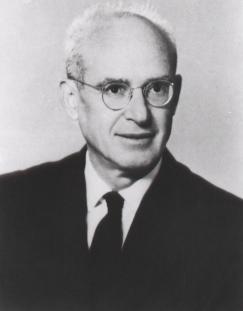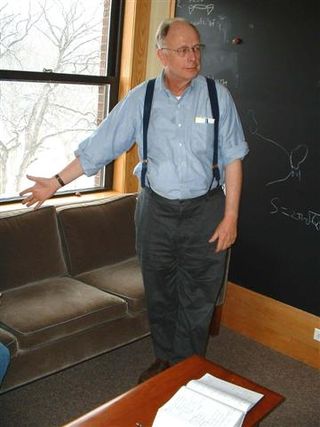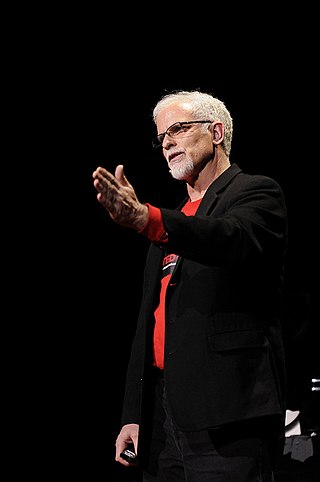Related Research Articles

In quantum field theory, the Casimir effect is a physical force acting on the macroscopic boundaries of a confined space which arises from the quantum fluctuations of the field. It is named after the Dutch physicist Hendrik Casimir, who predicted the effect for electromagnetic systems in 1948.

A wormhole is a hypothetical structure connecting disparate points in spacetime, and is based on a special solution of the Einstein field equations.
The Novikov self-consistency principle, also known as the Novikov self-consistency conjecture and Larry Niven's law of conservation of history, is a principle developed by Russian physicist Igor Dmitriyevich Novikov in the mid-1980s. Novikov intended it to solve the problem of paradoxes in time travel, which is theoretically permitted in certain solutions of general relativity that contain what are known as closed timelike curves. The principle asserts that if an event exists that would cause a paradox or any "change" to the past whatsoever, then the probability of that event is zero. It would thus be impossible to create time paradoxes.

The following is a timeline of gravitational physics and general relativity.

Kip Stephen Thorne is an American theoretical physicist known for his contributions in gravitational physics and astrophysics. A longtime friend and colleague of Stephen Hawking and Carl Sagan, he was the Richard P. Feynman Professor of Theoretical Physics at the California Institute of Technology (Caltech) until 2009 and is one of the world's leading experts on the astrophysical implications of Einstein's general theory of relativity. He continues to do scientific research and scientific consulting, most notably for the Christopher Nolan film Interstellar. Thorne was awarded the 2017 Nobel Prize in Physics along with Rainer Weiss and Barry C. Barish "for decisive contributions to the LIGO detector and the observation of gravitational waves".
In theoretical physics, negative mass is a type of exotic matter whose mass is of opposite sign to the mass of normal matter, e.g. −1 kg. Such matter would violate one or more energy conditions and show some strange properties such as the oppositely oriented acceleration for negative mass. It is used in certain speculative hypothetical technologies, such as time travel to the past and future, construction of traversable artificial wormholes, which may also allow for time travel, Krasnikov tubes, the Alcubierre drive, and potentially other types of faster-than-light warp drives. Currently, the closest known real representative of such exotic matter is a region of negative pressure density produced by the Casimir effect.
The chronology protection conjecture is a hypothesis first proposed by Stephen Hawking that laws of physics beyond those of standard general relativity prevent time travel on all but microscopic scales - even when the latter theory states that it should be possible. The permissibility of time travel is represented mathematically by the existence of closed timelike curves in some solutions to the field equations of general relativity. The chronology protection conjecture should be distinguished from chronological censorship under which every closed timelike curve passes through an event horizon, which might prevent an observer from detecting the causal violation.

Nathan Rosen was an American-Israeli physicist noted for his study on the structure of the hydrogen atom and his work with Albert Einstein and Boris Podolsky on entangled wave functions and the EPR paradox. The Einstein–Rosen bridge, later named the wormhole, was a theory of Nathan Rosen.
In general relativity, a Roman ring is a configuration of wormholes where no subset of wormholes is near to chronology violation, though the combined system can be arbitrarily close to chronology violation.

James Burkett Hartle is an American physicist. He has been a professor of physics at the University of California, Santa Barbara since 1966, and he is currently a member of the external faculty of the Santa Fe Institute. Hartle is known for his work in general relativity, astrophysics, and interpretation of quantum mechanics.
The λ (lambda) universality class is a group in condensed matter physics. It regroups several systems possessing strong analogies, namely, superfluids, superconductors and smectics. All these systems are expected to belong to the same universality class for the thermodynamic critical properties of the phase transition. While these systems are quite different at the first glance, they all are described by similar formalisms and their typical phase diagrams are identical.

Ronald William Prest Drever was a Scottish experimental physicist. He was a professor emeritus at the California Institute of Technology, co-founded the LIGO project, and was a co-inventor of the Pound–Drever–Hall technique for laser stabilisation, as well as the Hughes–Drever experiment. This work was instrumental in the first detection of gravitational waves in September 2015.
In physical cosmology, cosmological perturbation theory is the theory by which the evolution of structure is understood in the Big Bang model. It uses general relativity to compute the gravitational forces causing small perturbations to grow and eventually seed the formation of stars, quasars, galaxies and clusters. It only applies to situations in which the universe is predominantly homogeneous, such as during cosmic inflation and large parts of the Big Bang. The universe is believed to still be homogeneous enough that the theory is a good approximation on the largest scales, but on smaller scales more involved techniques, such as N-body simulations, must be used.
Harry L. Swinney is an American physicist noted for his contributions to the field of nonlinear dynamics.
Quantum dimer models were introduced to model the physics of resonating valence bond (RVB) states in lattice spin systems. The only degrees of freedom retained from the motivating spin systems are the valence bonds, represented as dimers which live on the lattice bonds. In typical dimer models, the dimers do not overlap.

Michael Lee Roukes is an American experimental physicist, nanoscientist, and the Frank J. Roshek Professor of Physics, Applied Physics, and Bioengineering at the California Institute of Technology (Caltech).
Until recently, most studies on time travel are based upon classical general relativity. Coming up with a quantum version of time travel requires physicists to figure out the time evolution equations for density states in the presence of closed timelike curves (CTC).

A causal loop is a theoretical proposition, wherein by means of either retrocausality or time travel, an event is among the causes of another event, which is in turn among the causes of the first-mentioned event. Such causally looped events then exist in spacetime, but their origin cannot be determined. A hypothetical example of a causality loop is given of a billiard ball striking its past self: the billiard ball moves in a path towards a time machine, and the future self of the billiard ball emerges from the time machine before its past self enters it, giving its past self a glancing blow, altering the past ball's path and causing it to enter the time machine at an angle that would cause its future self to strike its past self the very glancing blow that altered its path. In this sequence of events, the change in the ball's path is its own cause, which might appear paradoxical.
Manuela Campanelli is a distinguished professor of astrophysics and mathematical sciences of the Rochester Institute of Technology, and the director of their Center for Computational Relativity and Gravitation and Astrophysics and Space Sciences Institute for Research Excellence. Her work focuses on the astrophysics of merging black holes and neutron stars, which are powerful sources of gravitational waves, electromagnetic radiation and relativistic jets. This research is central to the new field of multi-messenger astronomy.

Sydney Meshkov was a Theoretical Physicist who worked in gravitational wave, atomic, nuclear and particle physics.
References
- ↑ Ph.D.'s Awarded by Caltech, with Thorne as the Thesis Advisor. California Institute of Technology. Retrieved 26 Apr. 2007.